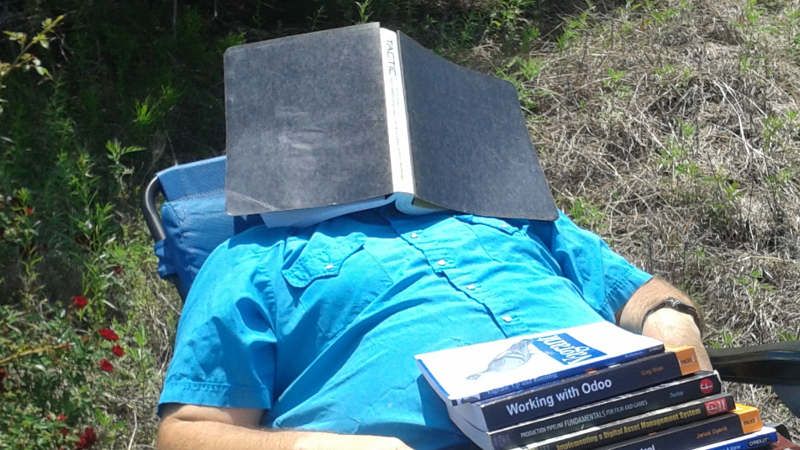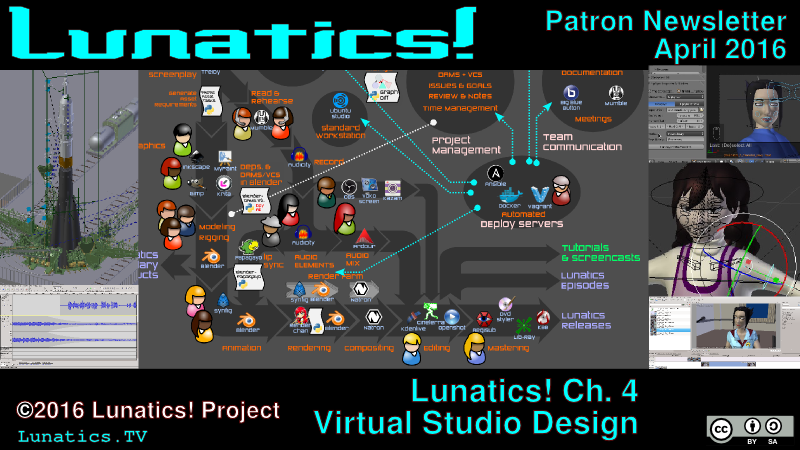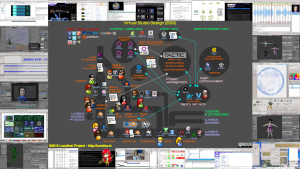After a one-month medical hiatus, Director & Producer (and Newsletter Editor!) Terry Hancock is back to work on Lunatics. We continue with installment 4 from Rosalyn Hunter’s serialization of “Lunatics!”. Otherwise, this month has been all about designing a Virtual Studio for Anansi Spaceworks (and the necessity to do so).
Lunatics!
Chapter 4 —
Uncle Sergei opened the door and winked at Georgy as she passed. Georgy liked Uncle Sergei. He was really Tim’s uncle, not hers, and he had a strong accent that sometimes made him hard to understand, but she liked him. He was funny.
The room that they entered had one wall made entirely of windows. There were people on the other side. Mama had explained to her that this was to keep them from getting sick, because someone might have a cold, and it would be a shame if they took the cold up into space and got sick there. The room made her feel like she was in an aquarium.
Mama sat down first, and then Sergei sat on the other side. She had a chair next to Mama. There were colored pencils and paper there, so she climbed into the seat and began to draw.
The people on the other side had been milling around talking, but when they had entered they’d turned toward them holding up microphones and pads. Lights flashed off of the glass until a woman raised her arms and said over the speaker, “Please, no flash photography. Thank You. Now if you will all take your seats, the press conference will begin.”
Georgy looked at Mama who was smiling. She smiled too. Several people took pictures of them, but Georgy soon got bored of it and went back to drawing.
“Ladies and Gentlemen. I will now introduce the members of this flight. The pilot and commander is veteran cosmonaut and lunar shuttle pilot Sergei Titov. This will be his thirty-seventh launch aboard a Soyuz and his tenth flight as commander.”
“Zdravstvujtye,” Sergei said nodding.
“His copilot is mission specialist and future lunar colonist Hiromi Learner. Mrs. Learner is a nutritionist and medic. She and her daughter will be going on to the ISF Lunar facility at the Laplace Promontory.”
“Hello everyone. Thank you so much for coming.”
“And last but certainly not least in our thoughts is Georgiana Learner, daughter of Hiromi and Dr. Robert Learner, the first child to travel into Space.”
“Hi!” Georgy said looking up and waving, “Nice to meet you.”
Her speech was followed by “aws” and “oohs” from the crowd including one rather loud exclamation of “How Cute!”
Georgy looked over at her mother whose eyes showed approval. She nodded back and then took out a green pencil to draw a picture of the park where she had seen the statue earlier that week.
The reporters began to ask questions and Mama and Sergei answered them. Most of the questions that they asked Mama were about her. Georgy never understood why everyone in the world seemed to be interested in her going into space. Lots of children went on trips with their parents. Her friend Mary had gone to the Philippines with her dad, and her cousin Mark had gone with his parents on a biking trip through Scandinavia. No one thought that that was strange. What was so strange about her going to live with her Daddy on the moon?
Georgy started drawing the base of the statue with a gray pencil. She mostly ignored what everyone was saying, but she looked up when she heard them laugh.
“Did you always plan to take your children with you to the moon,” a woman asked?
“No, actually our plan was to go to the moon and have children there.”
“Alone on the moon, weren’t you afraid?”
“Afraid of what?” Mama asked.
“Complications with the birth or pregnancy. Running out of diapers.”
The crowd laughed again. Georgy smiled.
“I guess we supposed that we would get by,” Mama said, “And let me take this moment to say that what we are doing, taking our daughter into space, is no different than what colonists have always done.”
‘Exactly’, Georgy thought, ‘just like I said’.
“When the first immigrants went to colonize the Americas it was, by no stretch of the imagination, safe. But people took their families with them. The family is the basic unit of society. You cannot start a new culture, a new society with only single men and women. We need families to make settlements and that means children.”
The reporter was frowning. She didn’t look very happy. She was probably one of those people who thought that space was too dangerous for kids. She hoped that they didn’t try to stop her from seeing Daddy like the people back home had done.
The frowning woman continued, “But aren’t you afraid that Georgiana might die in the harsh conditions of space?”
“She could die here.” Mama said, “Of diseases spread by overcrowding. Of natural disaster. Of crime. Honestly I think that she will be much safer there than here. This is not a decision that we took lightly or without thought. We evaluated everything. We created custom space suits, redesigned spaces in the vehicle. A massive amount of design work has gone into making sure that Georgy will have the safest trip possible. Honestly the trip to the moon will actually be less dangerous than driving her to school for a year.”
The announcer’s eyes shifted nervously as she motioned to another reporter who asked Uncle Sergei a question, “And Commander Titov what are your thoughts about the flight?”
“I’m looking forward to it,” he said smiling over at her. “Little Georgiana is like a little niece to me. It’s wonderful to think that I can show her where I work.”
The announcer tilted her head toward the door and Mama rose to her feet. Georgy stood and picked up her drawing and pencils. She took her mother’s hand, and they stood in front of the glass for a moment to let the photographers take pictures before filing back out of the door.
Once the door was closed, Mama’s smile fell off of her face. “I was worried for a minute,” she said to Sergei. “The last thing we need is for someone to mention that misguided child endangerment case again. As if taking a child to live with her family is some kind of crime. At least they can’t reach us here.”
“I think it went well.” Sergei said smiling. Mama nodded at him, but she still looked worried.
Last night she had been worried too, frowning at the boxes they had packed, some to come with them and some to leave behind. Georgy had sat on the bed waving her legs back and forth and thinking of her garden back home and how the marigolds would be blooming now.
“Big day tomorrow, Georgy. You need to take a bath and then go to sleep. Do you want some apples? I still have some.”
“No thank you, Mama.”
She climbed to her feet and was about to go get her pajamas when her mother hugged her to her chest and kissed her hair. “It’ll be okay, Georgy. Tomorrow we’ll get on the ship and everything will be fine. There’s nothing to worry about.”
“I know that Mama,” she said and pushed away from her.
That night when Mama tucked her into bed, she smiled and reached out to touch her hands. “Don’t worry mama,” she said, “everything will be fine and soon we’ll be with Daddy again.”
Mama looked into her eyes and smiled, “You’re right Georgy. Soon we’ll be with Daddy. Sweet dreams.” she said and kissed Georgy on the head before turning out the light.
Now Mama’s brow was wrinkled again. Georgy took her hand and squeezed it saying, “Don’t worry Mama. We’ll be with Daddy soon.”
Hiromi looked down at her daughter surprised out of her thoughts. She smiled. “You’re right, Georgy. We’ll be with Daddy very soon.”
Georgy looked at her drawing. At home she would have hung it on the wall, but she didn’t know where to put it now. She didn’t even know if she would be able to keep it. She put the drawing down on a nearby table and placed the drawing pencils in her pocket. She didn’t know when she’d have a chance to draw again.
The door opened and someone called in to say the bus was ready to take them to the launch site. Last night she had dreamed of rockets flying through the air spitting out starburst trails like fireworks, and bursting through clouds that glowed in the dawn light like golden sunflowers and marigolds. This morning she’d get to see it for real.
Chapter 5 coming in May!
So… I’m Back
“Lunatics!” has been pressing on for about four years now, and we’ve been starting to run into a point of diminishing returns on the effort we put in, which has been mentally and physically exhausting for me. Last month my stress levels apparently reached the point of causing medical complications. Since then, I’ve seen more doctors, tests, and medical equipment than I want to think about, and I now have official medical orders to chill the **** down and stop pushing myself so hard. Also to take time to eat better and get sleep. And lose weight.
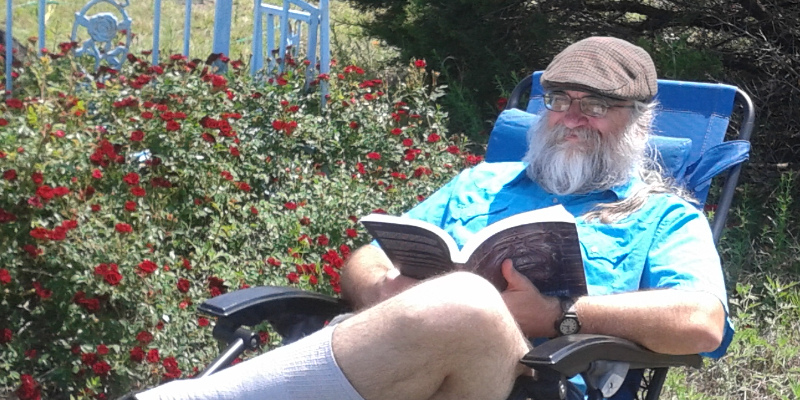
I’m grateful to be on the mend now, but I have to make some major changes, some of which affect this project.
I’ve decided that just pressing on as we have been is not viable for me, and I’ve got to invest in improving our studio environment and software in order to get things back on track. That is a lot of the motivation for the projects I’m talking about in this newsletter.
On the other hand, my more ambitious concept for the “Film Freedom” site is going to have to be curtailed substantially. That’s probably just going to be a site for notes and reviewed links to resources about film-making with free software and/or free culture distribution and business models. It’s probably not going to become a community site or involve much software development.
Designing a Virtual Studio for Anansi Spaceworks
My biggest problem is that we’re trying to create a series project without a studio. That’s not going to happen. So there are basically three alternatives left:
- Contract a Studio
- Join a Studio
- Build a Studio
Haven’t got the money for #1. Haven’t got any real options for #2. So #3 it is!
So, this month I’ve been researching this problem. It’s a big one.
It is not entirely a virtual project. We also need some brick & mortar work. My office has to be renovated, as we have not done properly since the fire in 2013. We need a better voice-recording booth, and we probably need to build a foley stage. I also still need to build a render cluster, and that also requires system administration and scripting work.
But we do need to work on the software infrastructure a lot, because we are most-of-all a virtual, through-the-web project.
Also, it’s very clear that I cannot do a whole lot of software development work, nor do I have resources to pay someone else to do it for me. So that means we’re dependent mostly on already-existing software. I thought for awhile that was going to mean we’d have to give up on using free/open-source software, but it turns out that’s not the case, and the following 20-minute video explains the discovery and design process I’ve been going through. Afterwards, I’ll go over some finer points the video skips.
A Virtual Studio for Anansi Spaceworks
For better reference, here’s that final layout picture at full resolution:
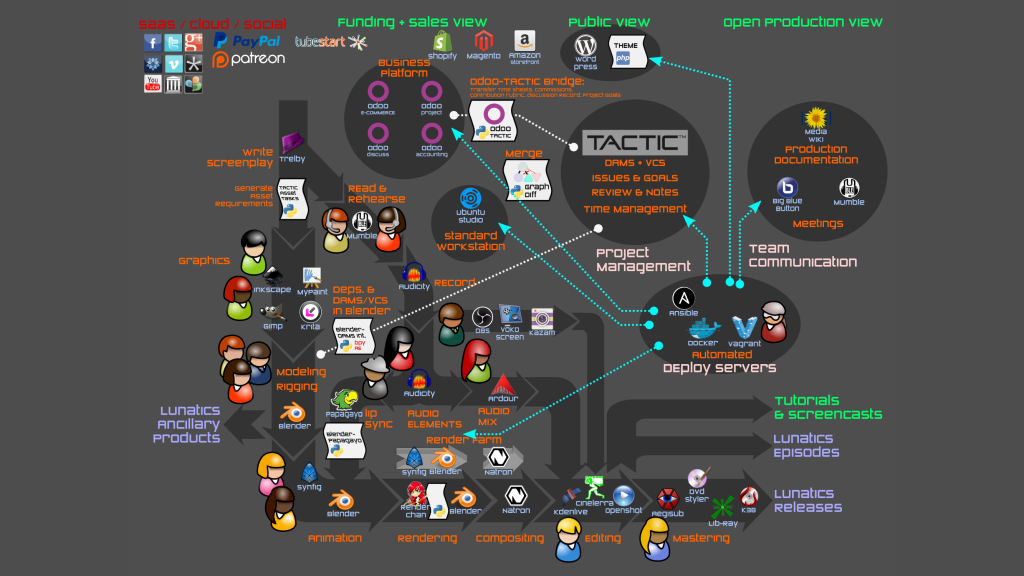
A few things I didn’t go into in the video:
We’ve used kdesvn, TortoiseSVN, and RapidSVN as clients for accessing the Subversion repository. Although I personally prefer kdesvn, it’s only available for Linux, and the artists are typically using Windows machines. I documented RapidSVN because it’s available for Windows, Mac, and Linux and appears to be very consistent across platforms.
I sort of skipped over why using Bazaar would matter so much for the GraphDiff project. That’s because Bazaar has a really nice call-back API for making diff comparisons between files. None of the other version control systems I’ve looked into has a clean interface for this, and it would make it a lot more feasible to extend Bazaar to handle automatic merging of Blender files. I have not studied the version control system in TACTIC well enough to know whether it would support this kind of modification or not. Of course, even without direct VCS support, a GraphDiff “Blender Merge” utility would be a big improvement over manually merging files.
TACTIC does not appear to have much pre-existing support for Blender (it does have some support for Maya). As I alluded in the video, it was an approach that was rejected by the Gooseberry project. I’m not exactly sure why that was, although it’s possible that it had not yet been released under a free license at that time.
The most convenient way for Blender artists to interact with TACTIC is not going to be through the web interface, but through a client written as a Blender plug-in so that the information is all available from within the Blender interface. Writing this Blender extension will be the main scripting challenge for the TACTIC-based studio scenario. This script will probably be responsible for checking Blender-linking dependencies, since the scripting interface provides means for us to test this. Remote calls to the TACTIC API should then be able to transfer this information to the DAMS so that TACTIC will generate correct dependency-based pulls for Blender.
Reading & Training
The next steps involve a lot of research before I can formulate a deployment plan. Basically, I have a long list of technologies and specific software I need to catch up on. Here’s an overview of my reading this month!
It is possible to learn most of this stuff from free online sources, of course, but I usually find that good tech books are well worth the cost, and I still prefer to read them on paper. So I’m going to list the books I’ve found most useful (or expect to).
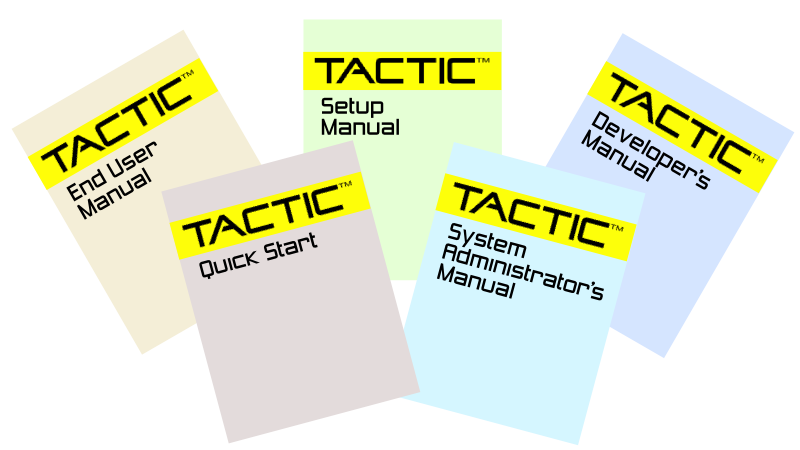
There aren’t any third-party books on working with TACTIC, but the official documentation
is very complete — over 600 pages of it in US Letter format, printed out from the ASCIIDoc sources. As you can see, they are divided into five separate manuals for different users. They are somewhat tedious reading, but nicely detailed. The “Quick Start” is only 18 pages, and the “End User” manual is 77 pages, so the burden on training artists won’t be so bad. Most of the text is for administrators, producers, and developers, who need really in-depth knowledge of the system.
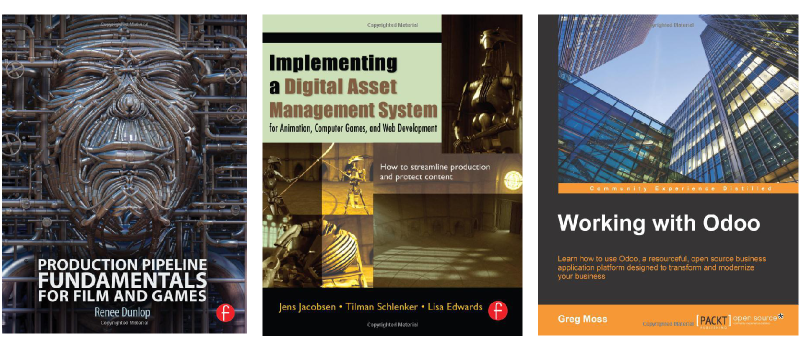
Two general books about the studio backend, and one introduction to using Odoo, which is more oriented towards the business and commerce side of the project. One of the things I hope to set up with Odoo is a means of maintaining accounts for contributors, so that sales profits can be distributed according to the (very complicated) rules we’ve decided on. It’s amazing how complex that can get, and it’d be a waste for all of the money to go to transaction fees because the amounts are so small. Better to let the funds accumulate and withdraw them in larger lumps. But the contributors should be in control of that. So we want something along the lines of what book publishers or marketplace sites allow people to do.
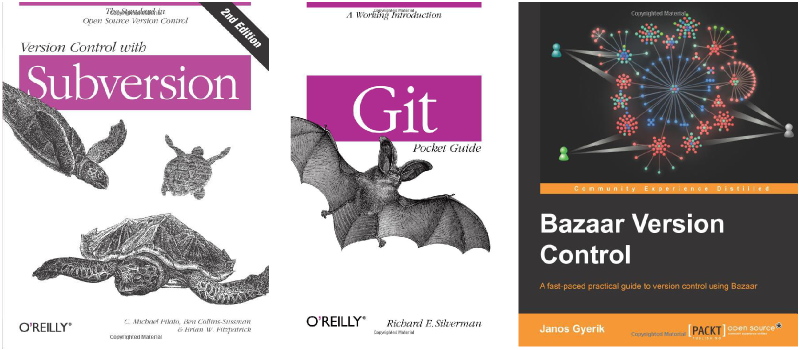
We’ve been using Subversion for years now, and this is the standard O’Reilly book on the subject, which I’ve been referring to during that time. I’ve never used Git, although it’s very popular with software developers — and I’m thinking about using GitHub to publish the code for Lib-Ray. So I got a fairly simple introductory book on using Git. Bazaar is not nearly as easy to find good documentation on, but there is this one book from Packt which I’m looking at now. Since I’ve pretty much decided to go with TACTIC, this is not for immediate use, but I’m still considering doing something with it in the future.
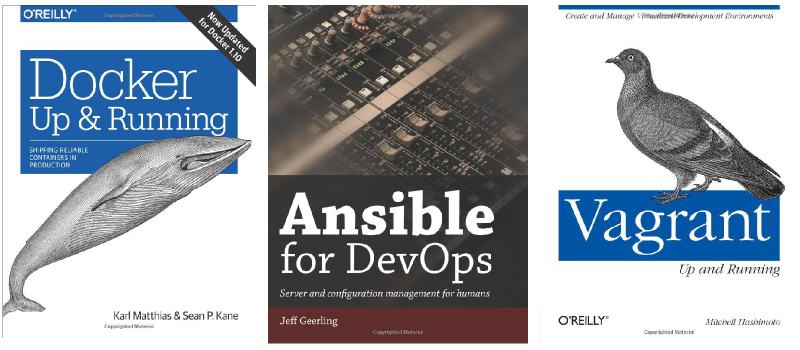
When Elsa Balderrama helped us with setting up our current WordPress site, she originally suggested using Docker to deploy it. I did not really understand why that might be a good idea, she didn’t push very hard, and we didn’t do it that way. But it got me curious about what Docker was. I’ve since learned that a whole new generation of system administration technologies have popped up, largely driven by the popularity of “cloud” services.
Vagrant is a virtual machine technology. You can use it to set up an isolated development environment or an isolated environment for a server to run in. Or indeed, you can do both so that the development environment is just like your production server, thus reducing the chance for errors when deploying your server software. This would probably be quite handy for setting up “disposable” servers, like our render cluster computers.
Docker is a “container” technology, which is similar to virtual machines in concept, but much lighter weight. The application lives in an isolated environment, but the operating system kernel is used directly, which reduces virtualization overheads. It also means that the kernel is maintained outside of the container, which can be good if you trust the people maintaining the kernel more than the ones maintaining the VM or container. This happens to be true for us, because I will be maintaining the containers, while the kernel on the server is maintained by professionals as part of our hosting service. This probably means that containers will be more secure for us than virtual machine solutions (or more precisely in our case, virtual machines inside of virtual machines, which seems a bit silly and wasteful to me, since our server is really a VPS).
Ansible is a “configuration management” and remote control automation system. We can use it to run commands on sets of remote servers en masse. This is probably the right way to run a lot of the maintenance we ought to be doing (but aren’t), like backing up our data, setting up and deploying containers, and so on.
I’ve basically skimmed all of these, but need to read them in more depth, and I will be referring to them as I get into setting up the deployment of our virtual studio software.
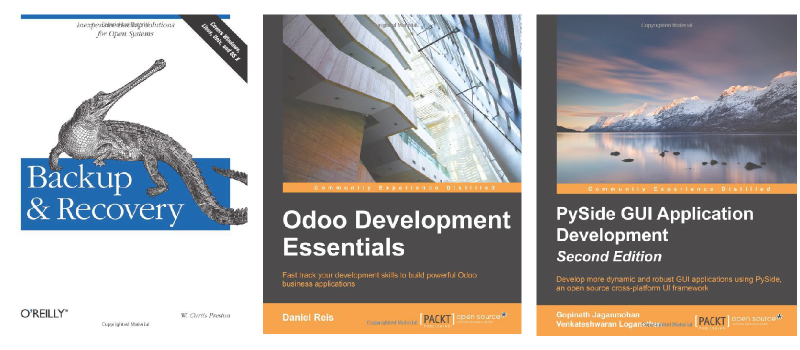
I don’t have these books yet, though I’ve ordered the Backup & Recovery book. I realized that all of the deployment software was only helpful for installing and configuring software, but that a big part of what I need to automate is properly migrating, backing up, and otherwise managing our data in the form of both database records and files. LAMP applications can be kind of sloppy about separating “code” from “data”, and so I realized that I probably needed quite a bit of guidance in getting this right. And I’d never really studied it.
The other two books are ones I’m considering for later phases of this project. Odoo development will be important if we want to bridge between other tools and the Odoo project management, e-commerce, and ERP suite. Finally, PySide is a Qt GUI library that could be useful if I decide to implement native desktop clients for some of the scripts I’m looking into. This is not my first choice. Other options include through-the-web interfaces and writing scripts in Blender Python (to run inside of Blender).
I don’t have a good book to recommend on scripting the new bpy interface in Blender 2.5+, which is what we’ll be working with. However, the online documentation is not too bad, and Blender has some pretty nice introspection and self-documenting features nowadays. Similarly, there’s no book on scripting TACTIC, except the Developer’s manual that I mentioned earlier, which can be generated from the TACTIC documentation sources.
As you can see, this is a LOT of reading and planning and training, and it’s been keeping me very busy this last month, as well as documenting my process. Setting up studio software is not a frequent task, and therefore few efforts have been made to document it well. I almost feel silly doing so now, as I doubt many of you reading this will go on to set up new studios based on it. But even for my own reference, it’s useful to document it and to voice my reasoning process. I hope you do get something out of it as well.
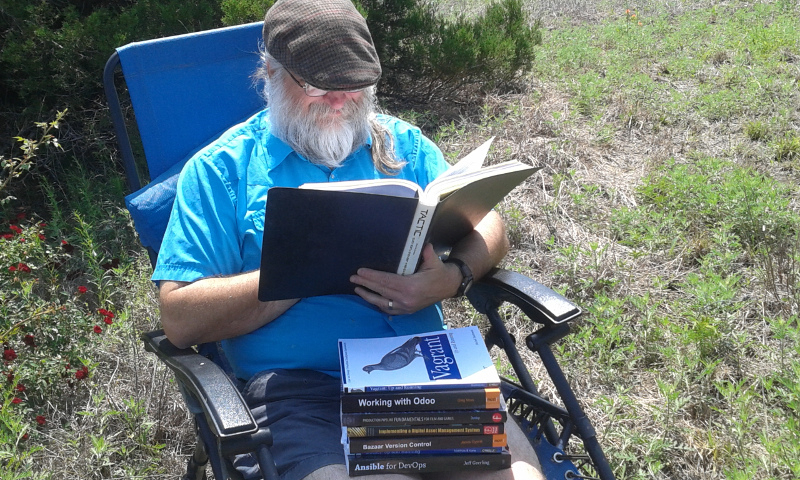
Other News
- Newsletters
- I just plan to pick up from here. I considered trying to do a big double issue, but really I think the important thing is to get on with the studio software and get back to production as soon as possible.
- Lib-Ray
- Haven’t talk about it much, but in March, I learned to use the Cairo graphics library bindings for Python, and got the test modules written for the spatial
navigation system. Also converted to using RML/RCSS for menus, rather than HTML/CSS — this is just a simplifying step, as I decided that what matters is getting it working. I also updated the menu internationalization code. Next up is loading and setting up the hyperlink callbacks on menu pages (basic menu-browser functionality). So actually, I’ve made a lot of progress with it recently. I expect to do a lot more in May. - Workspace
- I’m currently remodeling my library/office building so that I have a much better, larger, and cleaner place to work. I’m hoping this will help my personal productivity a lot.
Until Next Time!
